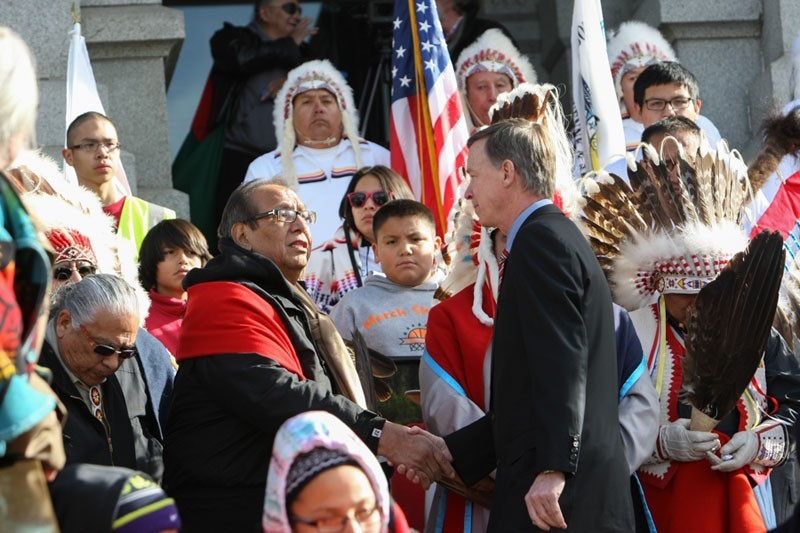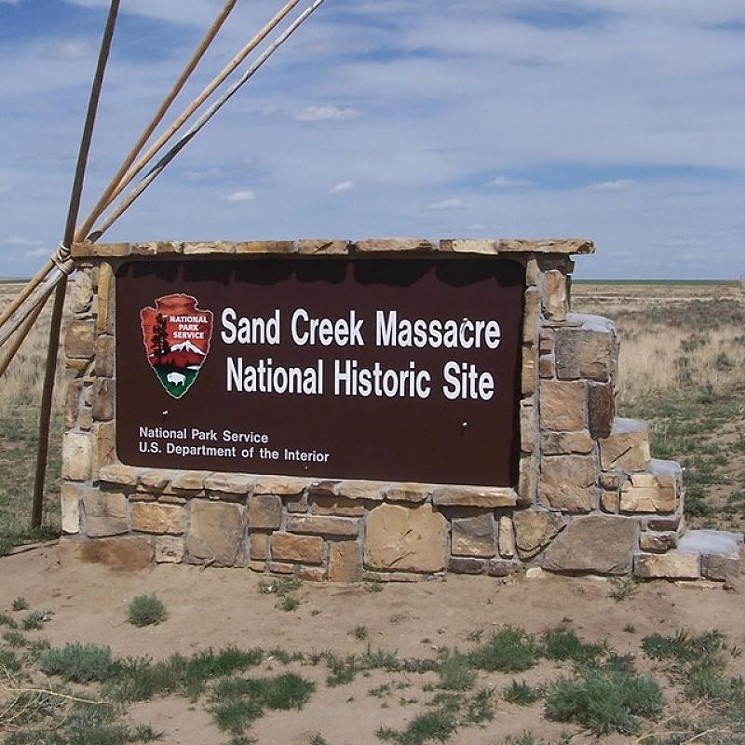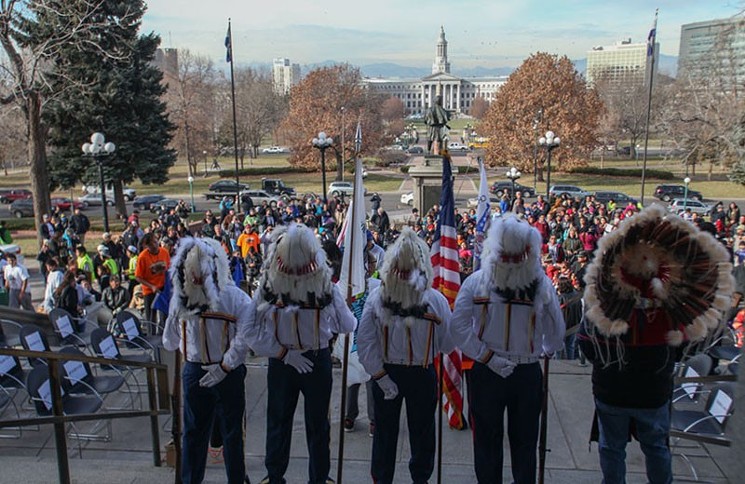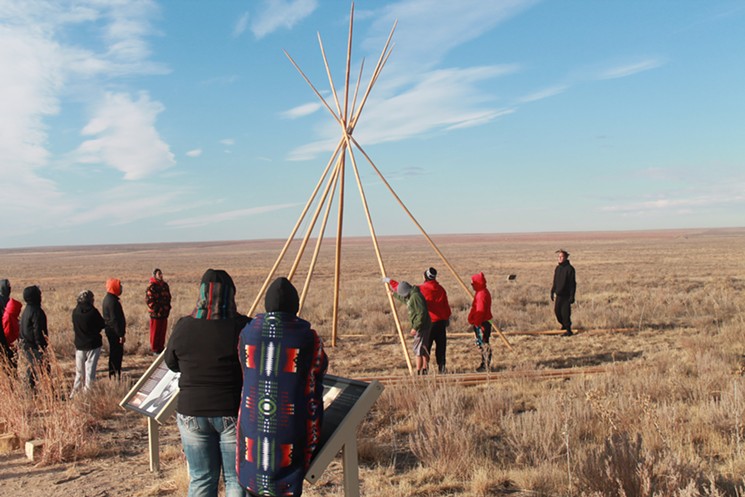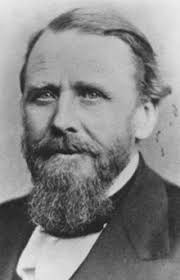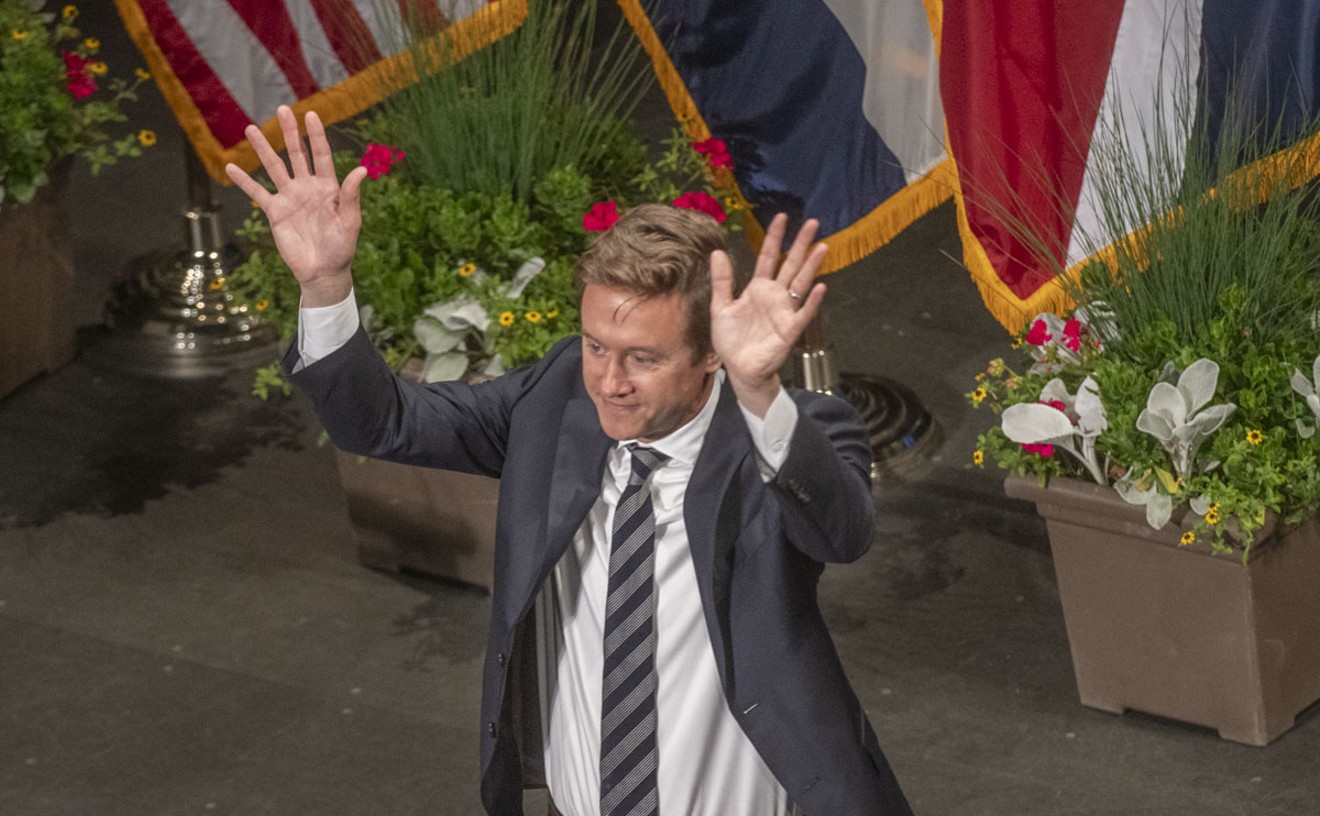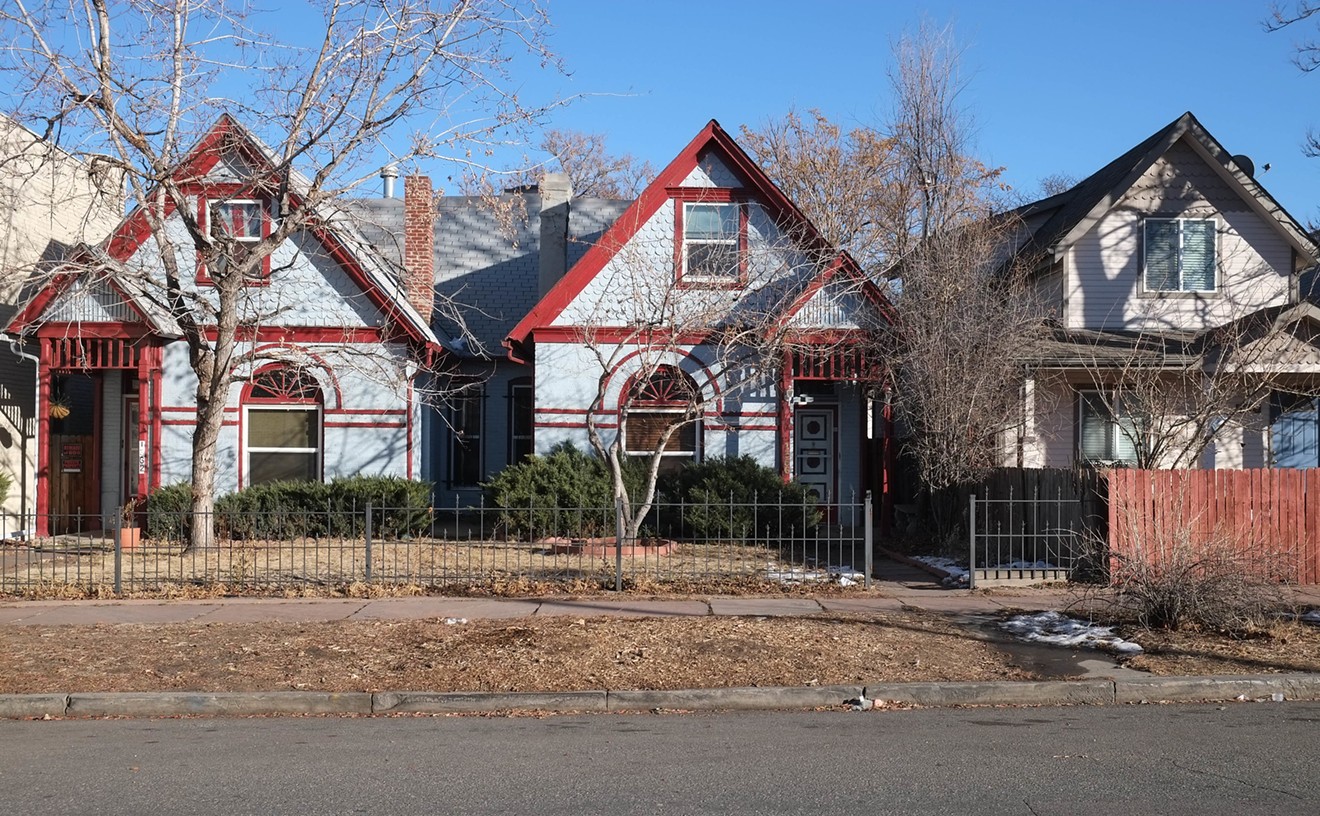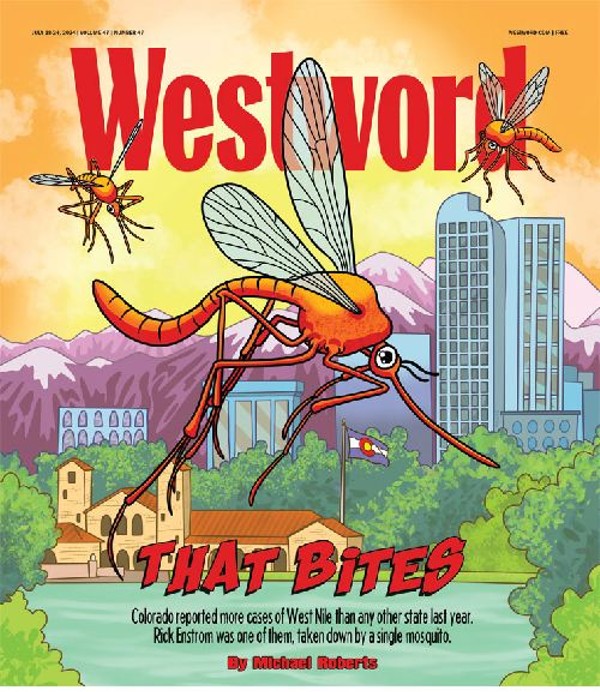Early on the morning of November 29, 1864, Colonel John Chivington and his band of volunteers slaughtered 200 Arapaho and Cheyenne, most of them women, children and the elderly, in their peaceful camp on the Big Sandy. This was a chiefs’ camp, one that the tribes believed was protected by the United States flag raised by Black Kettle. But Chivington — encouraged by John Evans, Colorado’s territorial governor and head of its Bureau of Indian Affairs, to create the Third Colorado Cavalry for a 100-day campaign designed “for immediate service against hostile Indians” — ignored all that.
Chivington’s men chased down tribal members and brutalized their corpses, taking plunder and grisly souvenirs back to the frontier town of Denver, 180 miles away, where they were displayed on a stage for Christmastime entertainment. Captain Silas Soule, one of the regular Army men riding with Chivington, refused to participate in the brutal action; he later described what he’d seen to General Edward Wynkoop, the officer who’d escorted Black Kettle to September 1864 peace talks in Denver. “The massacre lasted six or eight hours, and a good many Indians escaped,” he wrote. “I tell you Ned it was hard to see little children on their knees have their brains beat out by men professing to be civilized…. You would think it impossible for white men to butcher and mutilate human beings as they did.”
For the past twenty years, descendants of the tribal members who escaped by running up the banks of Sand Creek and ultimately running out of Colorado altogether, have gathered at the site of the slayings in southeastern Colorado to commemorate their ancestors at the Sand Creek Massacre Spiritual Healing Run/Walk. The run predates the 2000 congressional action that turned this land outside of Eads into the Sand Creek Massacre National Historic Site; although Congress conducted two investigations into Chivington’s actions at Sand Creek (the Army conducted a third) and officially declared it a “massacre” in 1865, it took another 135 years for Congress to put the atrocity on the map.
And the fight is not over yet.
This year’s Spiritual Healing Run started on November 22, Thanksgiving morning, at the Sand Creek Massacre National Historic Site. After traditional ceremonies at the site, about 200 runners left for Denver, following the route taken by Chivington and his men. They did not pause to consider Colorado’s fourteenth-highest peak, named for John Evans; instead, once they reached the city, their first stop on November 25 was Riverside Cemetery, where Soule was buried after he was murdered in April 1865. After speeches there, they moved downtown to the corner of 15th and Lawrence streets, where there’s a plaque for Soule, then turned toward the State Capitol. “That last mile, the crowd was easily a block long,” says Otto Braided Hair, the Northern Cheyenne leader who’s long been at the forefront of the run.
There were more speeches on the west side of the Capitol, facing Mount Evans and just dozens of feet away from the century-old Civil War Monument that lists Sand Creek as one of the battles fought by the Union. As awareness of one of Colorado’s more infamous chapters grew in the ’90s, some people wanted to remove the words “Sand Creek” from the Civil War Monument (if not remove the monument altogether). But members of the tribe, along with historians, stepped in and argued that history should not be erased, but explained. And so a new plaque was approved by the Colorado Legislature and added nearby:
“The controversy surrounding this Civil War Monument has become a symbol of Coloradans’ struggle to understand and take responsibility for our past. On November 29, 1864, Colorado’s First and Third Cavalry, commanded by Colonel John Chivington, attacked Chief Black Kettle’s peaceful camp of Cheyenne and Arapaho Indians...
“Though some civilians and military personnel immediately denounced the attack as a massacre, others claimed the village was a legitimate target. This Civil War Monument, paid for by funds from the Pioneers’ Association and the State, was erected on July 24, 1909, to honor all Colorado soldiers who had fought in battles of the Civil War in Colorado and elsewhere. By designating Sand Creek a battle, the monument’s designers mischaracterized the actual events. Protests led by some Sand Creek descendants and others throughout the twentieth century have since led to the widespread recognition of the tragedy as the Sand Creek Massacre.”
And the fight is not over yet.
On the 150th anniversary of the Sand Creek Massacre, at the end of the 2014 Spiritual Healing Run, Governor John Hickenlooper stood on the steps of the Capitol and addressed the descendants, reading from Soule’s letters, talking about the congressional committees that, even in the heat of the Civil War, could identify the inhumanity of a massacre, and describing the “deep moral failure” of Evans. And then he told the gathering, “This has been a day too long in coming. On behalf of the State of Colorado, I want to apologize.”
Colorado’s work would not end with that apology, he added. “We will not run from our history,” Hickenlooper said. “I will make sure this history continues to be told.”
One way to do that: place an official monument to the Sand Creek Massacre at the Capitol, on land the tribes once called their own. So for almost four years now, the Capitol Building Advisory Committee has been meeting to discuss just that. There’s a foundation that will pay for the monument, a prominent Native American artist with ties to both the Cheyenne and Arapaho who will design it...but so far, committee members have not been able to agree on a location. The descendants would like it close to the Civil War Monument, while less prominent alternatives have been offered: down the hill near Lincoln Street, on the other side of the Capitol near 14th Avenue. “One tribe is saying go for it, we may never get a chance again,” says Braided Hair. “But most of the tribes are saying no, wait.”
Over 154 years, the tribes have grown accustomed to waiting. And the fight is not over yet.
After the ceremony at the Capitol, the runners were served lunch at the History Colorado Center. That shiny new museum had opened in April 2012 with Collision, an exhibit dedicated to the Sand Creek Massacre that descendants had been criticizing for months. Even so, it took another year before the flawed Collision was closed; the tribes have been in consultation with History Colorado ever since on a replacement, which will greatly expand the discussion of Native Americans in Colorado. But here, too, location has become a sticking point. “We had a meeting about a month ago, and the exhibit location keeps being moved,” says Braided Hair.
“It’s disappointing. We’ve made more suggestions.” This spring, History Colorado will send representatives to the Cheyenne and Arapaho reservations, all outside of Colorado, to talk to the tribes about those suggestions and do more research.
In all the talk of how Sand Creek should be remembered, how new generations should be educated about the massacre, the tribes have not suggested changing names. In fact, when taking the name “Chivington” off a ghost town near Eads was proposed, tribal representatives on the Sand Creek Massacre Commemoration Commission then considering how to mark the 150th anniversary were adamant that the name should remain so that Chivington’s deeds would not be forgotten.
But now there’s a move to change the name of Mount Evans. “We don’t know who’s trying to do it,” Braided Hair says. “We don’t know what’s proposed.”
In June, a Denver Public Schools elementary school teacher petitioned the United States Geological Survey, proposing that Mount Evans be renamed Mt. Cheyenne Arapaho. She did so after learning about the territorial governor’s role in creating the climate that made the Sand Creek Massacre possible. That was the determination of a University of Denver investigation into Evans, a Methodist minister who’d founded the school as the Denver Seminary in 1864, shortly before he sent fellow minister Chivington on his bloody way.
Northwestern University, which had been co-founded by Evans a decade earlier in Illinois, conducted a similar investigation. The possibility of name changes has come up at both schools, where rooms and scholarships are named for Evans, but those are easy switches. Evans Avenue runs through DU’s campus. Northwestern is in the town of Evanston. The past is all around us, and changing a name does not change that.
The descendants are adamant on one point: Erasing the past is not the answer. People must be educated about what happened; they can never be allowed to forget. Hickenlooper’s extraordinary apology was just a step in the process. That’s why Braided Hair and other leaders continue to push for new curriculum in the schools, monuments and exhibits in our institutions, perhaps even the flags of tribes once based in Colorado inside the Capitol.
On that dark day in 1864, Chief White Antelope, one of the eleven chiefs killed at Sand Creek, sang his death song:
“Nothing lives long, only the earth and the mountains.”
No matter what they’re named.
Editor's note: Although the 2018 Sand Creek Massacre Healing Run/Walk ended on November 25, the commemorations will continue on the actual 154th anniversary, on Thursday, November 29, with a pair of free public programs at the Sand Creek Massacre National Historic Site. At 10 a.m., park guide John Launius will offer a walking tour of the site that takes visitors through the events leading up to and during the massacre, and the subsequent fallout over the attack. At 6 p.m. November 29, park guide Teri Jobe will offer a free program on Sand Creek Massacre survivor George Bent at the Crow-Luther Cultural Events Center (Plains Theater),1304 Main Street in Eads. For more information, call the park at 719-729-3003 or go to nps.gov/sand.
[
{
"name": "Air - MediumRectangle - Inline Content - Mobile Display Size",
"component": "12017618",
"insertPoint": "2",
"requiredCountToDisplay": "2",
"watchElement": ".fdn-content-body",
"astAdList": [
{
"adType": "rectangle",
"displayTargets": "mobile"
}
]
},{
"name": "Editor Picks",
"component": "17242653",
"insertPoint": "4",
"requiredCountToDisplay": "1",
"watchElement": ".fdn-content-body",
"astAdList": [
{
"adType": "rectangle",
"displayTargets": "desktop|tablet"
},{
"adType": "rectangle",
"displayTargets": "desktop|tablet|mobile"
}
]
},{
"name": "Inline Links",
"component": "18838239",
"insertPoint": "8th",
"startingPoint": 8,
"requiredCountToDisplay": "7",
"maxInsertions": 25
},{
"name": "Air - MediumRectangle - Combo - Inline Content",
"component": "17261320",
"insertPoint": "8th",
"startingPoint": 8,
"requiredCountToDisplay": "7",
"maxInsertions": 25,
"watchElement": ".fdn-content-body",
"astAdList": [
{
"adType": "rectangle",
"displayTargets": "desktop|tablet"
},{
"adType": "rectangle",
"displayTargets": "desktop|tablet|mobile"
}
]
},{
"name": "Inline Links",
"component": "18838239",
"insertPoint": "8th",
"startingPoint": 12,
"requiredCountToDisplay": "11",
"maxInsertions": 25
},{
"name": "Air - Leaderboard Tower - Combo - Inline Content",
"component": "17261321",
"insertPoint": "8th",
"startingPoint": 12,
"requiredCountToDisplay": "11",
"maxInsertions": 25,
"watchElement": ".fdn-content-body",
"astAdList": [
{
"adType": "leaderboardInlineContent",
"displayTargets": "desktop|tablet"
},{
"adType": "tower",
"displayTargets": "mobile"
}
]
}
]

